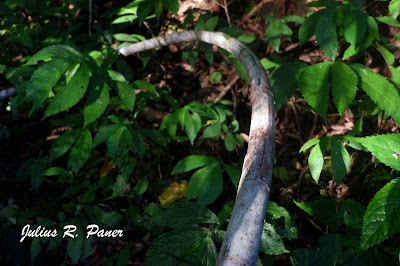Local authorities in
the Province of Camiguin is considering opening of new trail to Mt. Hibok-hibok,
paving way for the official launching of its Itom trail last March 23. I joined
the launching and familiarization day hike along with fellow mountaineers and
digital influencers from all over the country. Although there is a national advisory
of the mountain’s closure as a preventive maintenance before the El Nino
reaches its peak season this year, the launching is somehow very timely in
order for the LGU to further polish its regulations prior to the formal opening
of Itom trail anytime this year.
 |
| Pitcher Plants along Itom Trail |
The trail is approximately
a 6-kilometer stretch from the jump off point in the DENR PASU station to the highest
point which measures 1,332 masl. The climb was never a boring one as we were
entertained by the varied showcase of the trail’s biodiversity and the equally
jolly company of the expedition team. The cute summit offers another appealing
site to behold which had us witnessing a 360-degree view of the entire Camiguin
Island in broad daylight including the popular Vanishing and Mantigue Islands
and the adjacent highest point Mt. Timpoong on the other side.
 |
| Athrophaneura semperi supernotatos - a Philippine Endemic Butterfly |
Since the trail is new,
most of us had a slower pace which was really fine we were able to distinguish the
rich flora and fauna of Mt. Hibok-hibok. The jump off point itself is home to
assorted butterflies and birds while the entire trail serves host to amazing
flora species, some common to me while others are new and native in the place,
the most dominant are the huge tree species decorated with mosses, pitcher plants, wild romblon
and giant rattan. As we approached through higher elevation the vegetation
becomes stunted, proof of Mt. Hibok-hibok’s volcanic characteristics just like other
volcanoes in the country which has mineral vents and deposits.
We did not notice
presence of wild animals but some indirect observations led us to determine the
existing fauna in Mt. Hibok-hibok. Tracks of wild boar, sounds of common frogs,
dried skin of snake, leftovers of monkey foods and some personal romance with
leeches (I had one cute bite) simply manifest that the mountain is really unspoiled.
 |
| Track of Wild Boar |
 |
| Leftovers in a dining place of monkeys |
 |
| A dried snake skin |
 |
| Love at first leech bite |
The wide canopy of
trees in Mt. Hibok-hibok also serves as abode of several bird species. The Camiguin
Bulbul, endemic in the island, is the most widespread. This was previously
identified as the Yellowish Bulbul but was later on split due to its distinct
physical attribute and unique sound. I was even told by a local guide that
Camiguin Bulbul could produce 16 different sounds. A subspecie of Black-naped Monarch is another lifer, this one located only in Camiguin. This is an interesting subspecie though as told by Pete because there is no black in the nape. Other than these two Camiguin endemics I also saw appearances of Turquoise Flycatcher, Rufous Paradise
Flycatcher, Purple-throated Sunbird, Yellowish White Eye, Everett’s White Eyes,
White-eared Brown Dove, Spotted Dove, Philippine Cuckoo Dove, Brahminy Kite, Philippine Serpent Eagle, Yellow-vented
Bulbul, Olive-backed Sunbird, Zebra Dove, Orange-bellied Flowerpecker,
Red-keeled Flowerpecker, Coppersmith Barbet and the invasive Asian Glossy
Starlings.
 |
| A subspecie of Black-naped Monarch located only in Camiguin |
 |
| Spotted Dove |
 |
| Yellowish White Eye |
 |
| Yellow-vented Bulbul |
 |
| Rufous Paradise Flycatcher |
 |
| Camiguin Bulbul |
With all these
information it is but fitting that the LGU of Camiguin and the DENR should
level up their partnership in order to conserve and protect Mt. Hibok-hibok
amidst ecotourism activities. Ecotourism should be a tool to further boost the
mountain’s biodiversity and not a vehicle towards destruction.
Meanwhile, here is a
glass to the organizing committee of the launching climb for a job very well
done. Special credit is due to the Provincial Government of Camiguin
particularly the Tourism Officer Miss Candice, Potpot and the rest of the Gang,
as well as to the PASU office. Thank you so much for inviting me. You made us
all overwhelmed with the hospitality that I think is one of a kind in the
Philippines. The adventure turned out to be a gastronomic experience as well.
To USEC Art Boncato of
DOT, my salute to you Sir for helping local government units in advocating
responsible mountain tourism, or in the case of Camiguin – volcanic tourism. I
hope all leaders would be able to learn from you.
 |
| Pinoymountaineer.com author Doc Gideon Lasco and seven summitter Carina Dayondon |
 |
| The Fighter Boys led by Kulas |
To the solid group of
mountaineers, this is all about us and the mountain. By spreading good vibes we
will surely make this initiative rather than break it. It was nice climbing with
Carina Dayondon, the lone Filipina seven summitter, and to Doc Gideon Lasco who
had been responsible in spreading and enriching related literatures of
Philippine mountaineering. The group of Kulas was also a nice company in the
mountains, as well as the two pretty and intelligent influencers from Luzon
Celine Murillo and Kara Santos. And of course to renowned photographer and
mountaineer Rhonson Ng, thanks for the good company Brod.





































